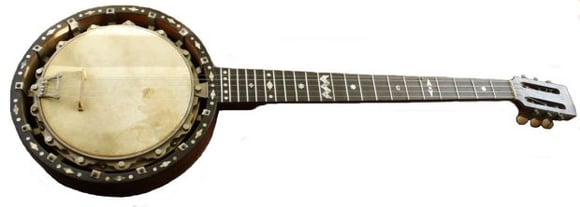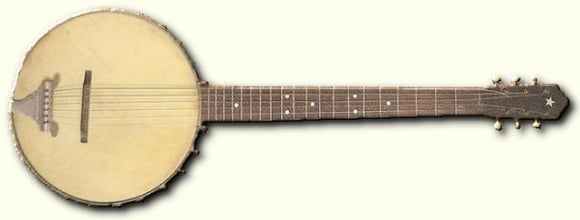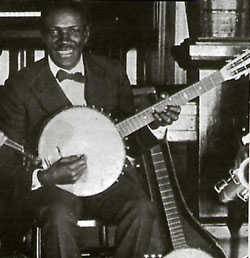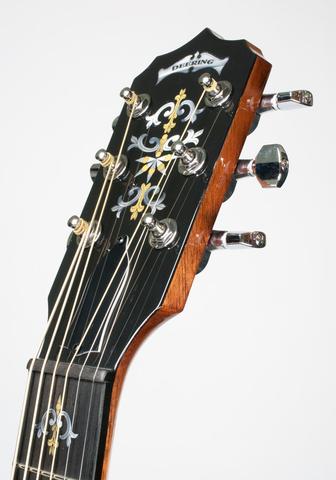One question I hear a lot is "what is a banjitar?" While I have dedicated years pointing out that in fact it is called a 6 string banjo, many folks dismiss the 6-string as some kind of marketing gimmick, born out of a demand from lazy guitar players who want to get a banjo sound without bothering to learn “real” banjo (by which they always mean 5-string, never 4-string).
If there is one kind of banjo that gets no respect, even from banjo players, it is the 6-string banjo.
But the truth is that the 6-string banjo was invented over a century ago, when the most popular fretted instrument in the U.S. was the mandolin, and the Jazz banjo was on the verge of replacing it. The guitar was barely "in the picture."
Actually, two kinds of 6-string banjo were invented, although only one is still being commercially manufactured today.
Some of the first 6-string banjos were based on a traditional 5 string banjo design. That is they kept the drone string but added a bass string between it and the fourth string (the lowest-pitched string on a 5-string). That allowed them to hit notes as low as G, depending on the tuning, giving them almost the range of a guitar.
 W. Temlett Zither Banjo
W. Temlett Zither Banjo
These were a bit more common in Europe, where "Zither Banjo" players played gut-string banjos in styles similar to classical guitars. A number of the 6-string zither banjos with drone strings have survived to this day. In addition, a few contemporary 5-string pickers have had similar 6-string banjos custom-built with drone strings to use for picking styles associated with traditional American music.
Owners of these instruments like to call them "Six String Banjos," which is fine. However, they like to call the far more common droneless six string banjos "Banjitars" or "guitjos" or other silly nicknames.
 Slingerland 6 String Banjo
Slingerland 6 String Banjo
I think they're trying to establish who the real 6-string banjo players are and who are the fakers. As a 5-string banjo player who can also play all three kinds of 4-string banjo, and both kinds of 6-string banjos, I don't consider myself a faker on any of those instruments, and I don't automatically assume that anyone else is either.
While zither banjos (mostly 5 string) were becoming popular in Europe, early Jazz and Jazz-inspired banjo playing was breaking all records in the United States. This includes what we might call traditional New Orleans Jazz or “Dixieland” today. By 1920 the banjo was as integral to popular music as the guitar is to rock & roll.
The most common banjo of the Jazz age was the four string Tenor banjo. These banjos abandoned the drone string because Jazz songs often used complex harmonization that a single note ringing on and on did not suit.
The Tenor banjo could only play relatively high notes, however. Jazz players who wanted more range investigated 6-string banjos that had also abandoned the drone string. Depending on how it is tuned, a 6-string banjo can go nearly an octave below most other banjos. Consequently, it can produce a range that is compelling and unique, while still providing an overall tonality that is all banjo.
Here’s something to consider. 6-string banjos were invented at a time when banjo was a far more popular instrument than guitar. There was never any hint that 6-string banjos were invented to make life easier for the relatively small number of guitar players in those days. They were invented to give Tenor banjo players access to lower notes. Period.
In fact, when Jazz guitar started becoming popular, Tenor banjo players flocked to the 4-string Tenor guitar because it allowed them to get guitar sounds without having to learn an entirely new instrument. Sound familiar?
Some sources claim that the influential Jazz guitarist Jean "Django" Reinhardt started out on a “droneless” six-string banjo (though he might be holding a Zither banjo in the photo people use most often for “proof.”
According to Diana Hergert, of California's Sweet Tidings Gospel Jam Band , Johnny St. Cyr's custom-made, droneless 6-string banjo appears on early jazz recordings of King Oliver's Creole Jazz Band (which at that time also included Louis Armstrong.)
 Johnny St. Cyr
Johnny St. CyrOddly, St. Cyr often used his 6-string to provide bass lines, something you can't do on a 4 or 5 string. Since I first published this article, I’ve received photos and questions about pre-WWII 6-string banjos from many parts of the world. As far as I can tell from the hardware in the photos, the vast majority of these were built by companies whose main product was banjos. Most of them seem to have been used for Jazz-related music, though at least one German-built 6-string was apparently used in a Polka band that had Ragtime numbers in its repertoire.
Like the 4-string Jazz banjo and its mate the Tenor Guitar, 6-string banjo seems to have been almost entirely overlooked by the Folk Revival movement, which might have made good use of it. But, of course that movement was largely sparked by Pete Seeger, a 5-string banjo player who helped bring that instrument into the mainstream in the mid-20th Century. And it was further popularized by guitar players. So many guitar players, in fact, that guitar displaced banjo as North America’s most popular instrument sometime around 1960.
The 4-string banjo did make an occasional appearance. In fact one version, the low pitched Irish Tenor banjo, became a staple of Irish Folk music.
My first 6-string banjo was a “pop-top” banjo (with an aluminum pot that had points sticking out). Though it worked for certain projects, it was too tinny and, frankly, the sustain was too long for most of the kinds of music I like.
Since then, I have experimented with several more 6-strings, all with wooden pots. I’ve managed to make a couple Asian imports play pretty well, but the truth is I got them cheap “used, like new” because the original purchaser got them from a store that didn’t “set them up” at all, so the instruments were basically unplayable out of the box.
For demanding work, I use a Deering Deluxe 6-string banjo that I found abused and nursed back to health.
 Deering Deluxe 6 String Banjo
Deering Deluxe 6 String Banjo
I like it for its sound and playability. I also like it for having a more authentic banjo scale length (26.25”). That sets it (and a handful of other 6-string banjos) apart from the companies that just glom a cheap guitar neck on a cheap banjo pot – their scale length is always the same as their guitars, about 24.5”
I have had to explain my 6-string banjo to more than one person who assumed that I was only playing it because I was too lazy to learn "real" banjo. Sometimes I switch off to 5-string just to show the cynics that I know what I’m doing.
The more I play and the more I learn, the more I realize that the 6-string banjo is not a hybrid anything; it’s a banjo in its own right, period. And it always has been.
This article is adapted from a piece by Paul Race. Originally published on creekdontrise.com as ”Are 6 String Banjos For Real?”
Seva Venet has traveled the world with a who's who of New Orleans traditional jazz musicians and plays the 6-string banjo in the style of the great Danny...
In this episode we journey into the wide world of the 6-String banjo with Sam Miller who heads up repairs here at Deering. Sam is a 5 and a 6-String banjo...
The 6-string banjo is as hard to classify as a platypus duckbill. It has been around for more than a century. It has a guitar neck, so it is really a guitar....
We recently had the chance to catch up with John D. Willis, a musician our ears are more familiar with than we realize! John is based in Nashville, TN and is...
3733 Kenora Dr.
Spring Valley, CA 91977
COMMENTS